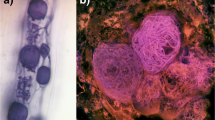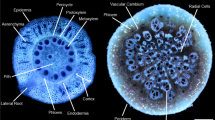Abstract
Symbiotic seed germination is a critical stage in orchid life histories. Natural selection may act to favor plants that efficiently use mycorrhizal fungi. However, the necessary conditions for natural selection – variation, heritability, and differences in fitness – have not been demonstrated for either orchid or fungus. With the epiphytic orchid Tolumnia variegata as a model system, we ask the following questions: (1) Do seeds from different individuals in a population differ in germination and seedling development in the presence of the same fungi? (2) Do different mycorrhizal fungi (Ceratobasidium spp.) differ in ability to stimulate seed germination and growth in T. variegata? And (3) are the Ceratobasidium isolates that best induce seed germination and seedling development more closely related to each other than to isolates that are less effective? We performed symbiotic seed germination experiments in vitro. The experiments were done using mycorrhizal fungi isolated from T. variegata; relationships among the fungi were inferred from nuclear ribosomal ITS sequences. We found significant variation for both symbiotic germination and seedling growth among biparental seed crops obtained from a population of T. variegata plants. Differences among Ceratobasidium fungi in seed germination were significant. The fungi that induced highest seed germination and seedling development belonged to two of four clades of Ceratobasidium. The two experiments show that there is potential for natural selection to act on orchid–fungus relationships. Given that orchids vary in performance, and that mycorrhizal fungi are not geographically distributed homogeneously, mycorrhizae may affect population size, distribution and evolution of orchids.
Similar content being viewed by others
References
J.D. Ackerman (1986) ArticleTitleCoping with the epiphytic existence: pollination strategies Selbyana 9 52–60
J.D. Ackerman (1995) ArticleTitleAn orchid flora of Puerto Rico and the Virgin Islands Mem. New York Bot. Gard. 73 1–203
J.D. Ackerman M. Galarza-Pérez (1991) ArticleTitlePatterns and maintenance of extraordinary variation in the Caribbean orchid, Tolumnia (Oncidium) variegata Syst. Bot. 16 182–194
J.D. Ackerman S. Ward (1999) ArticleTitleGenetic variation in a widespread, epiphytic orchid: where is the evolutionary potential? Syst. Bot. 24 282–291
J.D. Ackerman J.K. Zimmerman (1994) Bottlenecks in the life histories of orchids: resources, pollination, population structure, and seedling establishment A. Pridgeon (Eds) Proceedings of the 14th World Orchid Conference HMSO Edinburgh 125–129
J.D. Ackerman A. Sabat J.K. Zimmerman (1996) ArticleTitleSeedling establishment in an epiphytic orchid: an experimental study of seed limitation Oecologia 106 192–198 Occurrence Handle10.1007/BF00328598
J.D. Ackerman E.J. Meléndez-Ackerman J. Salguero-Faria (1997) ArticleTitleVariation in pollinator abundance and selection on fragrance phenotypes in an epiphytic orchid Am. J. Bot. 84 1383–1390
C. Alexander G. Hadley (1983) ArticleTitleVariation in symbiotic activity of Rhizoctonia isolates from Goodyera repens mycorrhizas Trans. Brit. Mycol. Soc. 80 99–106
R. Alexandersson S.D. Johnson (2002) ArticleTitlePollinator-mediated selection on flower-tube length in a hawkmoth-pollinated Gladiolus (Iridaceae) Proc. Roy. Soc. Lond. B 269 631–636 Occurrence Handle10.1098/rspb.2001.1928
J. Arditti A.K.A. Ghani (2000) ArticleTitleTansley Review No. 110. Numerical and physical properties of orchid seeds and their biological implications New Phytol. 145 367–421 Occurrence Handle10.1046/j.1469-8137.2000.00587.x
P. Bayman J.T. Otero J.D. Ackerman (2003) ArticleTitleHidden transactions: the curious relationships between orchids and fungi Orchids 72 536–537
D.R. Bolnick J.A. Svanback L.H Fordyce L.H. Yang J.M. Davis C. Darrin-Hulsey M.L. Forister (2003) ArticleTitleThe ecology of individuals: incidence and implications of individual specialization Am. Nat. 161 1–28 Occurrence Handle10.1086/343878 Occurrence Handle12650459
M.C. Brundrett (2002) ArticleTitleCoevolution of roots and mycorrhizas of land plants New Phytol. 154 275–304 Occurrence Handle10.1046/j.1469-8137.2002.00397.x
T.D. Bruns M.I. Bidartondo D.L. Taylor (2002) ArticleTitleHost specificity in ectomycorrhizal communities: what do the exceptions tell us? Integr. Comp. Biol. 42 352–359
R.N. Calvo (1993) ArticleTitleEvolutionary demography of orchids: intensity and frequency of pollination and the cost of fruiting Ecology 74 1033–1042
M.A. Clements (1982) Developments in the symbiotic germination of Australian terrestrial orchids J. Stewart C.N. Merwe Particlevan der (Eds) Proceedings of the 10th World Orchid Conference South African Orchid Council Johannesburg 269–273
Clements, M.A. (1987) Orchid–fungus–host associations of epiphytic orchids. In K. Saito and R. Tanaka (eds) Proceedings of the 12th World Orchid Conference,Tokyo, pp. 80–83.
M.A. Clements (1988) ArticleTitleOrchid mycorrhizal associations Lindleyana 3 73–86
R.K. Dixon H.E. Garrett H.E. Stelzer (1987) ArticleTitleGrowth and ectomycorrhizal development of loblolly pine progenies inoculated with three isolates of Pisolithus, tinctorius Silvae Genet. 36 240–245
N. Doebeli M. Knowlton (1998) ArticleTitleThe evolution of interspecific mutualisms P. Natl. Acad. Sci. USA 95 8676–8680 Occurrence Handle10.1073/pnas.95.15.8676
J.A. Endler (1986) Natural Selection in the Wild Princeton University Press Princeton
G. Hadley (1970) ArticleTitleNon-specificity of symbiotic infection in orchid mycorrhizae New Phytol. 69 1015–1023
G. Hadley (1984) ArticleTitleUptake of [14C] glucose by asymbiotic and mycorrhizal orchid protocorms New Phytol. 69 1015–1023
J.L. Harley S.E. Smith (1983) Mycorrhizal Symbiosis Academic Press London
M.M. Hart R.J. Reader (2002) ArticleTitleHost plant benefit from association with arbuscular mycorrhizal fungi: variation due to differences in size of mycelium Biol. Fertil. Soils 36 357–366 Occurrence Handle10.1007/s00374-002-0539-4
C.M. Herrera (2000) ArticleTitleIndividual differences in progeny viability in Lavandula latifolia: a long-term field study Ecology 81 3036–3047
C.C. Horvitz D.W. Schemske (1986) ArticleTitleSeed dispersal of a neotropical myrmecochore: variation in removal rates and dispersal distance Biotropica 18 319–323
C.C. Horvitz D.W. Schemske (1990) ArticleTitleSpatiotemporal variation in insect mutualist of a neotropical herb Ecology 71 1085–1097
N.C. Johnson J.H. Graham F.A. Smith (1997) ArticleTitleFunctioning of mycorrhizal associations along the mutualism–parasitism continuum New Phytol. 135 575–585 Occurrence Handle10.1046/j.1469-8137.1997.00729.x
G. Masuhara K. Katsuya (1994) ArticleTitleIn situ and in vitro specificity between Rhizoctonia spp. and Spiranthes sinensis (Persoon) Ames. var. amoena (M Bieberstein) Hara (Orchidaceae) New Phytol. 127 711–718
G. Masuhara K. Katsuya K. Yamaguchi (1993) ArticleTitlePotential for symbiosis of Rhizoctonia solani and binucleate Rhizoctonia with seeds of Spiranthes amoena var. amoena in vitro Mycol. Res. 97 746–752
S.L. McKendrick J.L. Leake D.L. Taylor D.J. Read (2002) ArticleTitleSymbiotic germination and development of the myco-heterotrophic orchid Neottia nidus-avis in nature and its requirements for locally distributed Sebacina spp New Phytol 154 233–247 Occurrence Handle10.1046/j.1469-8137.2002.00372.x
E.J. Meléndez J. D. Ackerman (1993) ArticleTitleThe effects of a rust infection on fitness components in a natural population of Tolumnia variegata (Orchidaceae) Oecologia 94 361–367 Occurrence Handle10.1007/BF00317110
E.J. Meléndez J.D. Ackerman (1994) ArticleTitleFactors associated with rust infection (Sphenosphora saphaena) in an epiphytic orchid (Tolumnia variegata) Am. J. Bot. 81 287–293
H.J. Muir (1989) Germination and mycorrhizal fungus compatibility in European orchids H.W. Prichard (Eds) Modern Methods in Orchid Conservation: The Role of Physiology, Ecology and Management Cambridge University Press New York 39–56
J.T. Otero (2002) Specificity of orchid mycorrhizae: their role in orchid evolution University of Puerto Rico Río Piedras
J.T. Otero J.D. Ackerman P. Bayman (2002) ArticleTitleDiversity and host specificity of mycorrhizal fungi from tropical orchids Am. J. Bot. 89 1852–1858
J.T. Otero J.D. Ackerman P Bayman (2004) ArticleTitleDifferences in mycorrhizal preferences between two tropical orchids Mol. Ecol. 13 2393–2404 Occurrence Handle10.1111/j.1365-294X.2004.02223.x Occurrence Handle15245412
M. Ramsey G. Vaughton (1998) ArticleTitleEffect of environment on the magnitude of inbreeding depression in seeds germination in a partially self-fertile perennial herb (Blandfordia grandiflora, Liliaceae) Int. J. Plant Sci. 159 98–104 Occurrence Handle10.1086/297525
H.N. Rasmussen (1995) Terrestrial Orchids: From Seeds to Mycotrophic Plants Cambridge University Press New York
H.N. Rasmussen (2002) ArticleTitleRecent developments in the study of orchid mycorrhiza Plant Soil 244 149–163 Occurrence Handle10.1023/A:1020246715436
P. Roberts (1999) Rhizoctonia-Forming Fungi: A Taxonomic Guide Kew Royal Botanical Garden, London
A.M. Sabat J.D. Ackerman (1996) ArticleTitleFruit set in a deceptive orchid: the effect of flowering phenology, display size, and local floral abundance Am. J. Bot. 83 1181–1186
I. Sanders (2002) Specificity in the arbuscular mycorrhizal symbiosis M.G.A. Heijden Particlevan der I. Sanders (Eds) Mycorrhizal Ecology Springer-Verlag Berlin 415–437
D.W. Schemske C.C. Horvitz (1984) ArticleTitleVariation among floral visitors in pollination: a precondition for mutualism specialization Science 225 519–521
M.A. Selosse M. Weiβ J.L. Jany A. Tiller (2002) ArticleTitleCommunities and populations of sebacinoid basidiomycetes associated with the achlorophyllous orchid Neottia nidus-avis(L.) L.C.M. Rich and neighbouring tree ectomycorrhizae Mol. Ecol. 11 1831–1844 Occurrence Handle10.1046/j.1365-294X.2002.01553.x Occurrence Handle12207732
J. Sharma L.W. Zettler J.W. Van Sambeek M.R. Ellersieck C.J. Starbuck (2003) ArticleTitleSymbiotic seed germination and mycorrhizae of federally threatened Platanthera praeclara (Orchidaceae) Am. Midl. Nat. 149 104–120
E.A. Smreciu R.S. Currah (1989) ArticleTitleSymbiotic germination of seeds of terrestrial orchids of North America and Europe Lindleyana 4 6–15
B. Sneh L. Burpee A. Ogoshi (1991) Identification of Rhizoctonia Species American Phytopathological Society, St. Paul Minnesota
E. Spoerl (1948) ArticleTitleAmino acids as source of nitrogen for orchid embryos Am. J. Bot. 35 88–95
D. Tagu P.F. Rampant F. Lapeyrie P. Frey-Klett P. Vion M. Villar (2001) ArticleTitleVariation in the ability to form ectomycorrhizas in the F1 progeny of an interspecific poplar (Populus spp.) cross Mycorrhiza 10 237–240
D.L. Taylor (2000) ArticleTitleA new dawn – the ecological genetics of mycorrhizal fungi New Phytol. 147 236–239 Occurrence Handle10.1046/j.1469-8137.2000.00709.x
D.L. Taylor T.D. Bruns (1997) ArticleTitleIndependent, specialized invasion of ectomycorrhizal mutualism by two nonphotosynthetic orchids P. Natl. Acad. Sci. USA 94 5410–5415
D.L. Taylor T.D. Bruns (1999) ArticleTitlePopulation, habitat and genetic correlates of mycorrhizal specialization in the “cheating” orchids Corallorhiza maculata and C. mertensiana Mol. Ecol. 8 1719–1732 Occurrence Handle10.1046/j.1365-294x.1999.00760.x Occurrence Handle10583834
D.L. Taylor T.D. Bruns J.R. Leake D.J. Read (2002) Mycorrhizal specificity and function in myco-heterotrophic plants M.G.A. Heijden Particlevan der I. Sanders (Eds) Mycorrhizal Ecology Springer-Verlag Berlin 375–414
D.L. Taylor T.D. Bruns S.A Hodges (2004) ArticleTitleEvidence for mycorrhizal races in a cheating orchid Proc. Roy. Soc. Lond B. 271 35–43 Occurrence Handle10.1098/rspb.2003.2557
J. Thomson U. Matthes-Sears R.L. Peterson (1990) ArticleTitleEffects of provenance and mycorrhizal fungi on early seedling growth in Picea mariana Can. J. Forest Res. 20 1739–1754
J.N. Thompson (1994) The Coevolutionary Process University of Chicago Press Chicago
J.N. Thompson J.J. Burdon (1992) ArticleTitleGene-for-gene coevolution between plants and parasites Nature 360 121–125 Occurrence Handle10.1038/360121a0
C.M. Tonnkin N. Malajczuk J.A. McComb (1989) ArticleTitleEctomycorrhizal formation by micropropagated clones of Eucalyptus marginata inoculated with isolates of Pisolithus tinctorius New Phytol. 111 209–214
R.L. Tremblay (1997) ArticleTitleDistribution and dispersion patterns of individuals in nine species of Lepanthes Biotropica 29 38–45
R.L. Tremblay J.D. Ackerman (2001) ArticleTitleGene flow and effective population size in Lepanthes (Orchidaceae): a case for genetic drift Biol. J. Linn. Soc. 72 47–62 Occurrence Handle10.1006/bijl.2000.0485
M.G.A. Heijden ParticleVan der T.W. Kuyper (2001) ArticleTitleDoes origin of mycorrhizal fungus or mycorrhizal plant influence effectiveness of the mycorrhizal symbiosis? Plant Soil 230 161–174 Occurrence Handle10.1023/A:1010377320729
M.G.A. Vander Heijden J.N. Klironomos M. Ursic P. Moutoglis R. Streitwolf-Engel T. Boller A. Wiemken I.R. Sanders (1998) ArticleTitleMycorrhizal fungal diversity determines plant biodiversity, ecosystem variability and productivity Nature 396 69–72 Occurrence Handle10.1038/23932
V. Vujanovic M. St-Arnaud D. Barabé G. Thibeault (2000) ArticleTitleViability testing of orchid seed and promotion of coloration and germination Ann. Bot. 86 79–86 Occurrence Handle10.1006/anbo.2000.1162
J.H. Zar (1999) Biostatistical Analysis EditionNumberFourth ed. Prentice Hall Upper Saddle River
Author information
Authors and Affiliations
Corresponding author
Additional information
Co-ordinating editor: J. Tuomi
Rights and permissions
About this article
Cite this article
Otero, J.T., Bayman, P. & Ackerman, J.D. Variation in mycorrhizal performance in the epiphytic orchid Tolumnia variegata in vitro: the potential for natural selection. Evol Ecol 19, 29–43 (2005). https://doi.org/10.1007/s10682-004-5441-0
Received:
Accepted:
Issue Date:
DOI: https://doi.org/10.1007/s10682-004-5441-0




